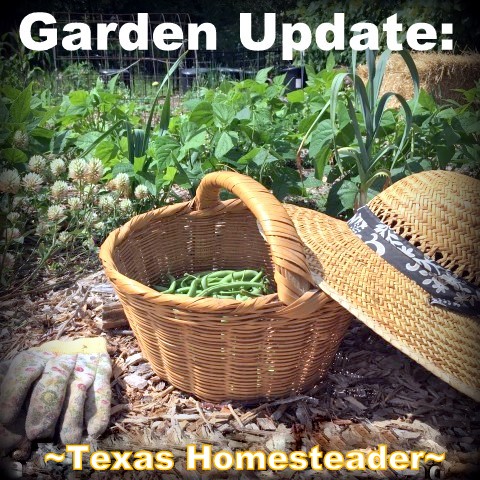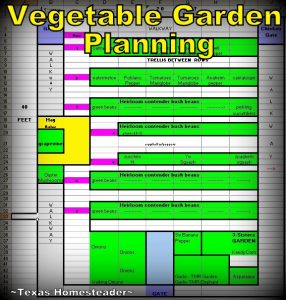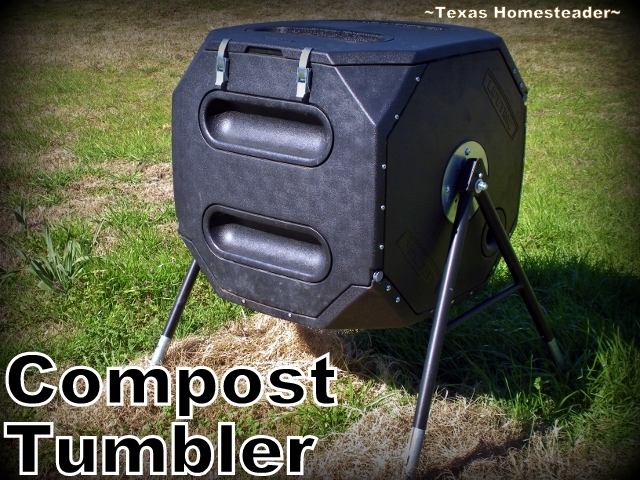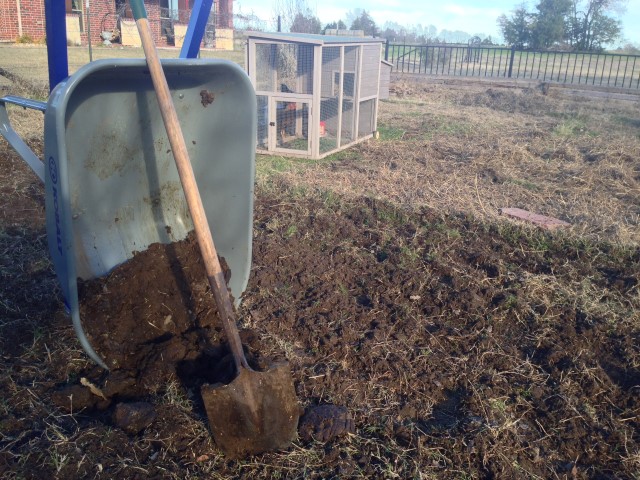by Texas Homesteader ~
*affiliate link
Even though it’s now winter RancherMan & I are taking steps now to assure a productive garden next spring. It’s now time to put the garden to bed for the winter.
One of the many blessings of living in NE Texas is that we’re often able to enjoy lovely temperate weather well into December. Even mid December we’re still enjoying cool days with highs in the mid to upper 60’s, even the mid to upper 70’s some days. Gotta love it!
So now that the garden is officially done for the season RancherMan & I are taking advantage of this warm weather streak to prepare the garden for war next year.
I hate Bermuda grass in the garden because it battles mightily to thwart my attempts to garden each. Every blasted year so I work with a goal of eliminating Bermuda grass in my garden. I’m not gonna lie, I’ve lost that battle every year so far. This past spring with a hopeful heart I tried Deep Mulching The Entire Garden Area to eliminate anything growing where it wasn’t desired.
Although it worked beautifully to eliminate grass & weeds, the wet spring meant that the Bermuda boldly marched across the TOP of my thick mulch, anchoring in roots along the way until it was firmly entrenched once again in my raised beds where it’s impossible to irradiate without starting over. (sigh…)
Changing My Garden Plans To Try To Defeat Bermuda Grass
So early this week I was helping RancherMan make plans to finally win the Bermuda war next season by ripping out my current shorter raised beds & building taller 3-ft high raised beds. Our thought was that even Bermuda couldn’t grow through 3 feet of soil to infiltrate my planting area.
But then a couple of days ago we switched the plan and decided we would keep the current shorter raised beds since they were already in place but eliminate Bermuda from coming into the garden area by constructing a chicken run around the perimeter of the garden.
Our thought was that an enclosed chicken tunnel run around the perimeter of the garden would allow the chickens a safe place to roam while keeping the grass scratched away before it reaches my planting area.
I love the symbiotic relationship between chicken needs and garden needs coming together to serve each other beautifully. But there were unworkable complications with that plan too – especially since my garden includes two walk-through gates on opposite ends – one entrance gate from the yard and one gate to gain access to the cistern that carries irrigation water to my plants. There was also the problem of my concord grapevine permanently growing along one fence. We just couldn’t realistically make the chicken tunnel work. Back to the drawing board…
Settling On A Garden Layout Plan
So a few days later we discussed our garden layout changes at length and now we’ve changed our CHANGE! We’ll still integrate the chickens into a section of this enclosed garden space and rototill raised rows to plant instead of being restricted to a specific wood-lined planting area. My actual garden planting area will be smaller but with about the same production since there will be less wasted space.
The chicken area will keep that section Bermuda-grass free, resulting in a smaller area we must tackle to stop the march of the Bermuda into my planting space. We’ll incorporate a no-planting zone around the perimeter of my planting area where we’ll attempt to control the Bermuda with a combination of tilling, mulch and even chemical control as a last resort.
Ripping Up And Starting Over
So with renewed hope the current raised beds were disassembled and the wood was stacked out of the way. We’ll repurpose that wood for use in remaking our picnic table as well as replacing some of the wide boards on our flatbed trailer so none of the valuable 2×6 long lengths of wood will go to waste. I got to work digging up the garlic that was sprouting in the beds and transferred them to large containers that were heavily mulched with grass clippings.
Then RancherMan brought out the tiller and shallowly tilled the new planting area but only about 3 inches deep. We don’t want to till too deeply since we’re just trying to break up the top layer and chop up the grass that’s currently growing there.
In the meantime I’d already emptied out my *Tumbling Composter so that the contents could finish making that precious black gold compost for next year’s garden. (Yes, I love that tumbler for the ease of making compost! )
I left a small amount of unfinished compost in the tumbler to give the next batch a jump start & also added several shredded heavy paper cattle feed sacks to give it some carbon ‘brown’ material to the mix and then I gave it all a whirl.
But I also wanted to add some manure so I got to work gathering it. It’s wonderful having this resource available to me for just the cost of my labor. I took a wheelbarrow to our hay-feeding area, gathered manure with a shovel and filled several wheelbarrows full.
I dumped about a 5-gallon bucket’s worth into my tumbling composter and gave it a final turn and the rest was all taken to the newly-tilled garden area and dumped in piles. I allowed the chickens that are currently restrained to the garden area scratch and spread the manure for me, then I took a dirt rake & spread it haphazardly throughout the tilled area.
RancherMan allowed this area to sit for several days and then he ran the tiller over it again to blend everything up nicely. He wants to allow it to sit undisturbed for a while before giving it one more light tilling after a cold hard freeze when everything’s finally dormant.
After that final tilling of the year we’ll seed the area with either winter rye grass, crimson clover or a mixture of the two – either will serve as a cover crop but the clover will also fix nitrogen into the soil. Then all that will be left to do is wait. We’ll retill this area in February to break up the cover crop, then again in March right before planting to make sure the ground is ready to receive my tender seedlings. Stay tuned to see if we finally successfully win the war against Bermuda grass in the garden next season!
~TxH~
My Favorite Garden Hacks
- Easy Garden Planning Spreadsheet
- Getting A Jump: Planting An Indoor Greenhouse
- Repurposed Cardboard Seed-Starting Pots
- 3-Sister’s Garden – The Original Companion Planting
- Low-Cost Vegetable Gardening
- Planting A Large Galvanized Trough
- Using Cheap Biodegradable Weed Block
- Tricking Birds AWAY From Your Strawberry Plants
- Easy Compost For A Healthy Garden
- Propping Tender Seedlings
- Cheap (or FREE) Wood Mulch For The Garden
- Homestead Hack: Remember Where You Planted Seeds
- How Vegetable Gardening Can Change Your Life!
- Easy Deep-Soak Watering
- Planting Potatoes In Galvanized Trough
- Planting A Blueberry Bush In Galvanized Tub
- Stevia – Growing Your Own Sweetener!
MORE Gardening Posts
C’mon by & sit a spell! Come hang out at our Facebook Page. It’s like sitting in a front porch rocker with a glass of cold iced tea – lots of good folks sharing! You can also follow along on Pinterest, Twitter or Instagram.
If you’d like to receive an email each time a new blog post goes live it’s EASY to
Subscribe to our blog!









Bermuda, where you need it, you can’t get it to grow, but in the garden it will choke everything out.
Wish you luck with the Bermuda grass. Here in southern Illinois, it’s quack grass and bindweed – each year I say I’m going to beat them, but it’s been 25 years so I think maybe they have the edge! Still harvesting collards and mustard from the garden, and I do scallions year round inside. I buy three bunches of green onions from the store (organic, with lower parts and roots still attached), use the tops and plant the lower 2 inches in long planters in gardening mix. They keep re-growing, I keep cutting off the tops to use, etc – can keep these going for a long time – at least 6-7 months! The planters move to the deck in the late Spring, and back in in mid-Fall. HUGE return on investment!
I wish you luck with that bermuda grass, it’s horrible and thankfully I don’t have it here on my property. I live in Pennsylvania yet had the same kind of summer you did. We had rains and flooding that killed much of my new seedlings then drought that took care of most of the rest. I’ll be spending this winter planning gardens that will be protected from the rains while at the same time drought conditions should we have them again. I think weird summers will be a constant problem so planning for both will ensure productive gardens in the future.
Bermuda grass is such a terrible ‘weed’ to deal with here in Texas!!! I won the battle battle by going down 12 inches and putting in a concrete footing all around the garden area. Did cost us $ to have done, but was what a delight it has been to never have bermuda in the garden again. My husband and I sat on hands and knees for a week in the afternoons and dug out all the rhizome after concrete footing was put in …. results, NO more bermuda … now going on 8 years! Delightful soil now after years of cover cropping and rotating crops.
We did win the battle after years of continuous war!
I’m dealing with bermuda in the flower bed in front of my house. My husband was kind enough to transplant it along with the soil he excavated from another part of the yard. Didn’t want to let all that good organic matter (you know, the roots that live forever and allow it to spread) go to waste! In the spring, I’m digging up all the perennials and putting down black plastic mulch (that I read about at the Deliberate Agrarian) to see if I can kill it out that way. I’ve had no luck with cardboard (it rotted down before the bermuda died out) or with wood chips (can’t put it on thick enough to smother the grass). I’m just thankful that we did not choose a spot for our vegetable garden that had the horrid stuff growing in it.
It was pure dumb luck. There are patches of our back yard that have bermuda (we didn’t even know what it was, or that we had any of it) and patches that don’t. The only relatively flat spot in our yard that we chose for the garden just didn’t happen to have it. Previous owners may have used a grass killer in that area, or maybe we just have such a lot of rain (Ozark plateau) that other grasses are better able to compete. I’d guess that maybe the necessity for frequent mowing might also help to keep it in check.
I am slowly eating the last of my garden. Pulled a bunch of carrots and picked chard and kale. I’ll leave the plants until they start bolting in the spring. The down side is that my soil doesn’t have time to rest between seasons, that’s why I augment it with peat and manure each spring. My compost is buried in a pit to “cook” through the winter under a plastic tarp. By spring it will be ready to use in place in my upper garden area. Each year they soil deepens in a section that I’ve created from nothing but a steep slope on a granite cliff. It still has trouble holding moisture, but I won’t give up. – Margy
You are so right – Bermuda grass is horrible! We don’t have much of it, but plenty of other things take its place:) Good luck.